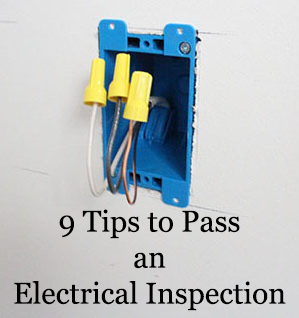
Just this morning, my local township electrical inspector stopped by and reviewed the electrical work I had performed for our home office improvement project. He gave us a passing grade, which means I officially have approval to cover the framing with drywall and finish the room. He pointed out a couple changes I need to make before he returns, so I do need to take care of those issues. This is probably the third or fourth time he’s been out to our house for an inspection so I’ve learned to prepare for the things he likes to see.
9 Tips for Passing an Electrical Inspection
If you are considering attempting your own electrical work on your next project, I implore you to apply for electrical permits from your local government.
Applying to do my own work was a simple process. In this case, all I did was fill out a couple of simple forms where I stated my name, address, the scope of the work being performed (adding 4 recessed lights) and the estimated cost of the work related to the permit. After about two weeks, the township called me and let me know my permit was approved and ready for pickup. I paid a $61 fee to the township and got started on the rough-in work. Once I complete the rough-in work, I schedule the inspector and he pays me a visit.
The most anxiety inducing part of this process is the rough-in inspection, but if you follow these general guidelines, you’ll be much more likely to pass the first time.
1. Ask the Inspector First. When you schedule the inspector, try to actually have a conversation with him or her about what they expect to see and what pitfalls you can avoid. All inspectors should be looking for the same checks, but some have additional requirements or pet-peeves that can fail you. Checking with them first is a great way to establish a name to a face and get a sense of their general requirements.
2. Don’t Add Any Devices. During the rough-in inspection, there can’t be any devices on the circuits you are adding. No outlets, no lights, no switches, nada, nunca. If you are adding an outlet to an existing circuit, then the NEW outlet should also not be installed either. The rest of the outlets on that circuit that were originally there are probably fine, but if you disturbed the wiring in any outlet, it shouldn’t have a device for the inspection.
3. Tie Your Grounds Together. In each outlet or electrical box location, the ground wires should be tied together. This is something my inspector noted today. Don’t tie anything else together though. The hot and neutral leads should remain separate.
4. Fire Block. Any holes or penetrations from one floor to the next or from one wiring passage to the next needs to be blocked so as to prevent a fire using the hole as a breathing hole or chimney. Typically, you can use fire block expanding foam (which is bright orange in color) or regular fiberglass insulation to fill or plug these kind of holes.
5. Plug Holes in Boxes. This one was new to me and I’ll have to fix it. The electrical box I used have these bendable tabs where the cable enters. Well one of these tabs snapped off. The inspector told me I need to plug it. I’ll probably use insulation and jam it in the hole here.
6. Use Correct Breaker. Another correction I’ll have to make is the circuit breaker I installed. The breaker in this application needs to be an 15 amp Arc Fault Circuit Interrupter (AFCI) and I had installed a regular 15 amp breaker. The AFCI’s prevent arcs and are required on all circuits that feed living spaces (I think). You can buy AFCI’s in any hardware store and they are several times more expensive than regular breakers.
7. Don’t Power the Circuit. Although the wires for the new circuit can be tied into the new breaker, the breaker needs to remain off or unpowered. It shouldn’t be powered up until all the devices are installed.
8. Cover the Wires with Wire Nuts. All the wire ends need to have wire nuts on them even if they don’t have any exposed conductor. Same goes for the ground wires.
9. Secure Cables with Staples. Cable runs need to be secured to framing every so many feet with cable staples.
That’s pretty much all I have for the rough-in inspection. If you have any others, please leave them in the comments. If you’ve never done your own electrical work, then I suggest you work with someone more experienced before you attempt it yourself. Be safe and good luck.
If you enjoyed this post, please share it.
Have any inspection horror stories? I’d love to hear those too, so leave them in the comments section.